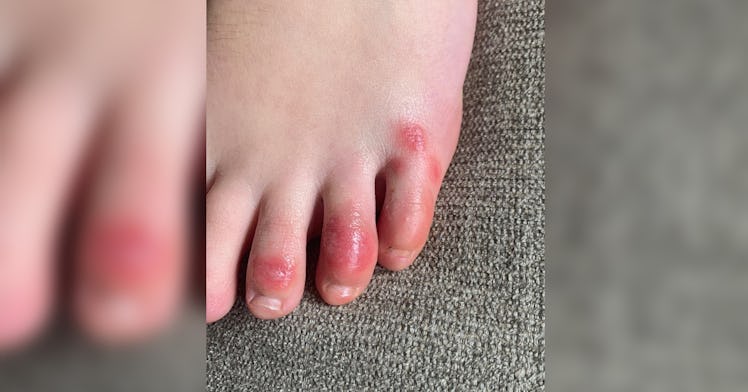COVID Toes Are a Coronavirus Clue for Kids Without Symptoms
But what are "COVID toes?"

Across the country, kids that seem otherwise healthy are developing purple, blue, and red lesions on their toes and sometimes their fingers. Yes, there’s likely a coronavirus link here, and enough evidence is mounting that some experts have dubbed the symptom “COVID toes.”
Many children with the condition don’t have a telltale cough or fever, but some have viral symptoms the week before their toes become discolored, said Amy Paller, chair of dermatology at Northwestern University Feinberg School of Medicine, in a press release. However, other experts say that COVID toes appear in children before disease symptoms arise. “This is a manifestation that occurs early on in the disease, meaning you have this first, then you progress,” Ebbing Lautenbach, chief of infectious disease at the University of Pennsylvania Perelman School of Medicine, told USA Today.
There are currently no studies on COVID toes, and all reports are anecdotal, so it’s difficult for experts to determine the relationship between the coronavirus and the lesions. Furthermore, a few of these kids have been tested for the disease it’s named after, and many of them have received negative results. “We don’t know for sure if it’s related to COVID-19,” Paller said, “but when it’s so common right now during a pandemic and is occurring in otherwise asymptomatic or mildly affected patients, it seems too much of a coincidence not to be a manifestation of the virus.” It won’t be possible to understand the association between the two until more COVID-19 testing is available. For now, Paller recommends antibody testing to investigate the relationship in young people without other symptoms, though it might be best to hold off until experts can determine which tests are reliable.
COVID toes may present only as a discoloration — “from bright red to a dusky purple to anything in between,” Paller told Fatherly. However, the affected toes may also be itchy or painful. Usually, the tops of toes are affected, though there can also be circles of color on the bottom of the foot or the big toe. The condition, which was first recognized by an Italian scientist in March, can also include a hot, burning sensation, Lautenbach said.
The symptom mostly occurs in children above age 10, teenagers, and young people. But experts have also observed COVID toes in middle-aged and elderly adults, some of whom have tested positive for coronavirus. In fact, some adults with severe COVID-19 and this discoloration have even lost their toes, Paller says.
There are two main explanations experts are suggesting for why COVID toes occur. First, they could be caused by blood clots. Or, Lautenbach said, the cause could be inflammation affecting the small blood vessels of the feet and toes. Paller is leaning toward the second explanation. She heard second-hand that a pathologist biopsied COVID toes of an adult patient and didn’t find blood clots. However, it doesn’t have to be one explanation or the other and could be a combination of both, Esther Freeman, a dermatologist at Massachusetts General Hospital, told TODAY.
Young people may get COVID toes more often than adults because they have stronger immune systems, Lautenbach said. Inflammation — the likely cause of the condition — is a type of immune response. But it’s difficult to know for sure. Experts don’t know much about COVID toes, partly because families of those with the condition may not think to report it. After all, who would guess funky toe colors would be related to the coronavirus? But from the little information available, Paller suspects that the symptom is fairly common. Since she put out an alert to a local hospital a week and a half ago, she has already received about 40 reports of the condition.
COVID toes seem to go away on their own, Paller says, though it can take anywhere from a few days to a month or two. Though the symptom doesn’t require treatment, you can give your child ibuprofen if they are in pain. If their feet are itchy, ask a doctor about cream to apply to the skin.
If your child’s feet develop blue, purple, or red splotches, keep them at home in quarantine — just like you’re already doing. But there’s not enough evidence linking COVID toes and its namesake to assume your child is infected and isolate them for 14 days. Paller recommends documenting any symptoms that develop, looking into antibody tests, and taking pictures to send to experts for research.